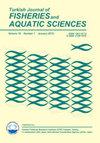Heterogeneous Growth Prediction in Farmed Tilapia
IF 1.7
4区 农林科学
Q3 FISHERIES
引用次数: 1
Abstract
This study displays the application of the quantile regression theory to predict the size heterogeneity of cultured organisms. The analysis was applied to empirical data of the tilapia cultured in freshwater. Tilapia was cultured at four diets (50%, 80%, 100%, and Satiation). The quantile regression (QR) demonstrated to successfully model the size heterogeneity in tilapia (p<0,05; u<0,20), due to the feeding strategies effect. These results indicate tilapia fed an 80% ration size simulated a maximum biomass of 2,345.17 and 2,853.38kg at the harvest size of 200-300g (at 180 days) and 300-400g (at 210 days). The simulation of the quantile curves at a higher production scale allowed an estimate of the biomass distribution according to different market sizes, this strengthens management decision making in tilapia aquaculture. Implications of quantile regression and size heterogeneity in aquaculture are presented here.养殖罗非鱼异种生长预测
本研究展示了分位数回归理论在预测培养生物大小异质性中的应用。该分析应用于淡水养殖罗非鱼的经验数据。罗非鱼采用四种饲料(50%、80%、100%和饱和)培养。分位数回归(QR)成功地模拟了罗非鱼的大小异质性(p< 0.05;U <0,20),受摄食策略的影响。这些结果表明,饲喂80%日粮的罗非鱼在200-300克(180天)和300-400克(210天)收获量时的最大生物量分别为2,345.17和2,853.38kg。对较高生产规模下的分位数曲线进行模拟,可以估算出不同市场规模下的生物量分布,从而加强罗非鱼养殖的管理决策。本文介绍了水产养殖中分位数回归和大小异质性的含义。
本文章由计算机程序翻译,如有差异,请以英文原文为准。
求助全文
约1分钟内获得全文
求助全文
来源期刊

Turkish Journal of Fisheries and Aquatic Sciences
FISHERIES-MARINE & FRESHWATER BIOLOGY
CiteScore
3.10
自引率
0.00%
发文量
43
审稿时长
3 months
期刊介绍:
Turkish Journal of Fisheries and Aquatic Sciences" (TrJFAS) is a refereed academic journal has been published by Central Fisheries Research Institute of Turkey and Japan International Cooperation Agency (JICA), and published in English.
It aims to address research and needs of all working and studying within the many varied areas of fisheries and aquatic sciences.
The Journal publishes English language original research papers, critical review articles, short communications and technical notes on applied or scientific research relevant to freshwater, brackish and marine environments.
TrJFAS was published biannually (April & November) between 2001 and 2009. A great number of manuscripts have been submitted to the journal for review from acceptance of the SCI index. Thereby, the journal has been published quarterly (March, June, September and December) from 2010 to 2017. The journal will be published monthly in 2018.
 求助内容:
求助内容: 应助结果提醒方式:
应助结果提醒方式:


